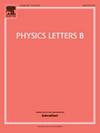史瓦西黑洞的高斯三向转向
IF 4.3
2区 物理与天体物理
Q1 ASTRONOMY & ASTROPHYSICS
引用次数: 0
摘要
多部转向是一种基本的量子资源,特别适合于解决复杂的相对论量子信息挑战,但其在引力场背景下的特性仍有待阐明。研究了在史瓦西黑洞背景下高斯三向转向的分布。我们的研究结果表明,在任何霍金温度下,物理上可获得的2→1可操纵性都保持稳健,这与随着霍金温度升高而经历“猝死”的1→1操纵行为形成了对比,使2→1可操纵性成为相对论量子信息任务更可靠的候选者。值得注意的是,我们观察到量子转向的突然死亡伴随着转向不对称的峰值,这标志着相对论三模系统从双向转向到单向转向的关键转变。我们发现,Wang et al.(2016)[73]表明,霍金效应可以在两个方向上产生二部系统不可达的双向转向,而在三部系统中只能产生物理上不可达的单向2→1转向。这些见解增强了我们对黑洞视界附近多部转向的再分配的理解。本文章由计算机程序翻译,如有差异,请以英文原文为准。
Gaussian tripartite steering in Schwarzschild black hole
Multipartite steering is a fundamental quantum resource that is uniquely suited to tackling complex relativistic quantum information challenges, but its properties in the gravitational field context remain to be elucidated. We study the distribution of Gaussian tripartite steering in the background of a Schwarzschild black hole. Our results show that physically accessible steerability remains robust at any Hawking temperature, which contrasts with the behavior of steering that experiences “sudden death” as the Hawking temperature increases, making steerability a more reliable candidate for relativistic quantum information tasks. Notably, we observe that the sudden death of quantum steering is accompanied by a peak in steering asymmetry, signifying a critical transition from two-way steering to one-way steering in the relativistic three-mode system. We find that the Hawking effect can generate inaccessible two-way steering of a bipartite system in both directions, as shown in Wang et al. (2016) [73], while it can only generate physically inaccessible one-way steering in tripartite systems. These insights enhance our understanding of the redistribution of multipartite steering near the event horizon of the black hole.
求助全文
通过发布文献求助,成功后即可免费获取论文全文。
去求助
来源期刊

Physics Letters B
物理-物理:综合
CiteScore
9.10
自引率
6.80%
发文量
647
审稿时长
3 months
期刊介绍:
Physics Letters B ensures the rapid publication of important new results in particle physics, nuclear physics and cosmology. Specialized editors are responsible for contributions in experimental nuclear physics, theoretical nuclear physics, experimental high-energy physics, theoretical high-energy physics, and astrophysics.
 求助内容:
求助内容: 应助结果提醒方式:
应助结果提醒方式:


